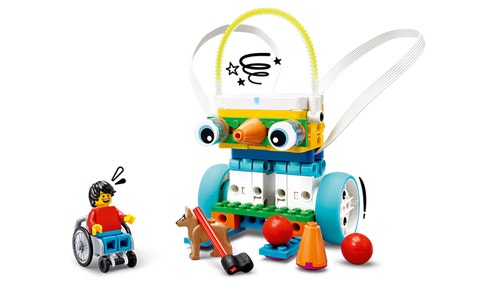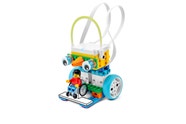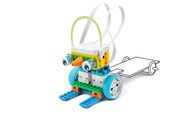Big Little Helper
Daniel’s locker is overflowing. How can he get all of his things home?

Prepare
- Review the Big Little Helper lesson in the LEGO® Education SPIKE™ App.
- If you feel that it would be beneficial, pre-teach these related vocabulary words: control, constraint, design, robot and solution.
- Consider the abilities and backgrounds of all your pupils. Differentiate the lesson to make it accessible to everyone. Please refer to the Differentiation section below for suggestions on how to do this.
- If time permits, plan and facilitate the maths extension. Please refer to the Extension section below for further information.
Engage
(Whole Class, 5 Minutes)
- Facilitate a quick discussion about solving a problem that has constraints.
- Talk with your pupils about moving everything out of your classroom into another one, with one catch. They must finish the move within 10 minutes!
- Ask questions like these: How could you empty the classroom in the shortest amount of time? What if you only had four classmates to help you?
- Introduce your pupils to the story’s main characters and the first challenge: controlling the robot helper.
- Distribute a brick set and a device to each group.
Explore
(Small Groups, 30 Minutes)
- Have your pupils use the LEGO® Education SPIKE™ App to guide them through their first challenge:
- Create and test the program that controls the robot helper.
- Have your pupils iterate and test their models to complete the next two challenges in the app:
- Program the robot helper to follow Daniel home.
- Design your own improved robot helper.
- You can find coding and building help in the Tips section below.
Explain
(Whole Class, 5 Minutes)
- Gather your pupils together to reflect on their completed challenges.
- Ask questions like these: How did you help Daniel to get all of his belongings home? How is the design of your robot helper different from Daniel’s?
Elaborate
(Whole Class, 5 Minutes)
- Prompt your pupils to discuss and reflect on ways of creating a possible solution to a problem that has constraints.
- Ask questions like these: Why is it important to consider constraints when you are designing a solution? How do constraints affect your design process?
- Have your pupils tidy up their workstations.
Evaluate
(Ongoing Throughout the Lesson)
- Ask guiding questions to encourage your pupils to ‘think aloud’ and explain their thought processes and reasoning in the decisions they have made while building and programming their models.
Observation Checklist
- Measure your pupils’ proficiency in creating a possible solution to a problem that has constraints.
- Establish a scale that suits your needs. For example:
- Requires additional support
- Can work independently
- Can teach others
Self-Assessment
Have each pupil choose the brick that they feel best represents their performance.
- Yellow: I think that I can create a solution to a problem that has constraints.
- Blue: I can create a solution to a problem that has constraints.
- Green: I can create a solution to a problem that has constraints, and I can also help a friend to do it.
Peer Feedback
- In their small groups, have your pupils discuss their experiences working together.
- Encourage them to use statements like these:
- I liked it when you…
- I would like to hear more about how you…
Tips
Coding Tips
- After your pupils have completed their first challenge, they will be provided with a map.
- Using the map, they should experiment with the available coding blocks to modify their programs to follow the route for the trip.

Model Tip
- After your pupils have completed their second challenge, they will be provided with three Inspiration Images and an open-ended prompt, which will help them to improve their models.
- The Inspiration Images are meant to help spark their imaginations as they experiment and personalise their models.




There are no specific building instructions for this challenge.
Differentiation
Simplify this lesson by:
- Selecting one Inspiration Image to help your pupils personalise their models
- Experimenting with either the coding or the building
Increase the difficulty by:
- Designing different bases to assist the robot helper in carrying Daniel's things
- Programming the robot helper to follow a predetermined route
Extension
- Have your pupils use graph points to map the robot helper's path. They should use the x- and y-axis to plot where the robot helper travels. They can also plot the path of another group’s helper.
If facilitated, this will extend beyond the 45-minute lesson.
ACMSP096
Construct suitable data displays, with and without the use of digital technologies, from given or collected data. Include tables, column graphs and picture graphs where one picture can represent many data values
Teacher Support
The pupils will:
- Create a possible solution to a problem that has constraints
- Improve upon others’ ideas in order to develop a new program
- Engage effectively in a range of collaborative discussions
(one for every two pupils)
- LEGO® Education SPIKE™ Essential Set
- Device with the LEGO® Education SPIKE™ App installed
Design and Technologies
ACTDEP014
Critique needs or opportunities for designing and explore and test a variety of materials, components, tools and equipment and the techniques needed to produce designed solutions.
Mathematics
ACMSP096
Construct suitable data displays, with and without the use of digital technologies, from given or collected data. Include tables, column graphs and picture graphs where one picture can represent many data values.
Science
ACSIS055 & ACSIS066
Consider the elements of fair tests and use formal measurements and digital technologies as appropriate, to make and record observations accurately.




